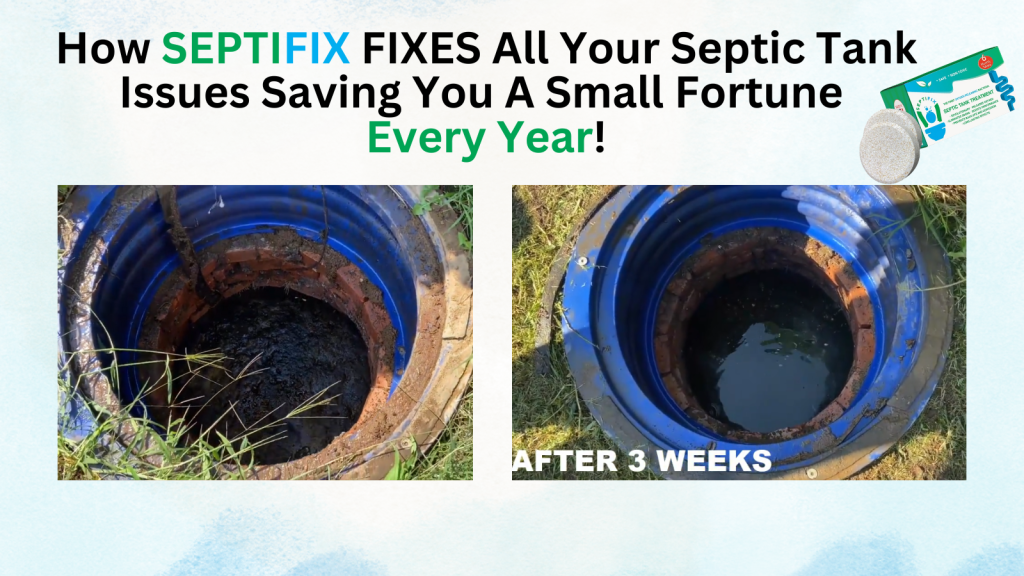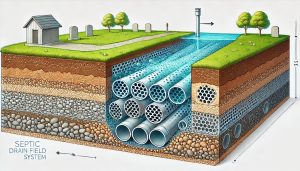Lush grass over the drain field might seem like a sign of healthy soil, but it often indicates a septic system issue. Excessive nutrients or water from the septic system can cause this abnormal growth. Ignoring this warning sign can lead to costly repairs or environmental hazards. In this article, we’ll explore why this happens, the potential problems, and how to address them effectively.
Table of Contents
- Why Is Grass Greener Over the Drain Field?
- Common Causes of Lush Grass Over the Drain Field
- Signs of Septic System Failure Beyond Lush Grass
- How to Address Lush Grass Over the Drain Field
- Preventative Maintenance Tips
- Environmental and Financial Risks of Ignoring Lush Grass
- Septifix
- Septic Permit Links by State
Why Is Grass Greener Over the Drain Field?
Increased Nutrient Levels
When a septic system malfunctions, wastewater may not properly filter through the soil. Nutrients like nitrogen and phosphorus can leak into the drain field, causing lush grass growth. These nutrients act as fertilizers, encouraging rapid grass growth in the affected areas. While this might seem harmless, it indicates an imbalance in how the septic system is processing waste.
Excess Moisture
Excess moisture from a failing drain field can also create ideal conditions for grass to thrive. If wastewater isn’t dispersing evenly, it can oversaturate certain areas. This oversaturation provides ample water supply, resulting in unusually green and healthy-looking grass. Persistent moisture can also damage nearby vegetation and soil structure.
Uneven Wastewater Distribution
Uneven distribution of wastewater often occurs when pipes are clogged or damaged. This leads to concentrated nutrient release in specific areas, which explains the patchy appearance of lush grass over the drain field.
Common Causes of Lush Grass Over the Drain Field
Septic Tank Overflow
An overflowing septic tank can send untreated waste into the drain field, leading to nutrient overload and unusually green grass. Regular pumping is essential to avoid this issue. When the tank is not emptied on schedule, solids can flow into the drain field, clogging pipes and reducing efficiency.
Clogged Drain Field Pipes
Blockages in the drain field pipes can prevent proper wastewater distribution. This issue results in concentrated moisture and nutrients in one area, leading to noticeable patches of lush grass. Blockages are often caused by non-biodegradable materials or excessive sludge buildup.
Soil Compaction
Compacted soil reduces the drain field’s ability to absorb and filter wastewater. As a result, water and nutrients accumulate, promoting excessive grass growth. Avoid driving heavy machinery or vehicles over the drain field to prevent soil compaction. Compact soil also reduces oxygen flow, which septic bacteria need to break down waste effectively.
Tree Root Intrusion
Tree roots can infiltrate septic system pipes, causing blockages and damage. These roots seek out nutrient-rich wastewater, which can further exacerbate the issue. Regular inspections can detect early signs of tree root intrusion, preventing costly repairs.
Poor Septic System Design
In some cases, the problem might stem from the original design of the septic system. Incorrect sizing, improper soil evaluation, or poor installation can result in wastewater distribution problems. A professional inspection can identify if design flaws are contributing to the issue.
Signs of Septic System Failure Beyond Lush Grass
Lush grass is just one sign of a potential septic system failure. Look out for these additional warning signs:
- Slow drains in the home
- Foul odors near the drain field
- Standing water or soggy ground
- Gurgling noises in plumbing fixtures
- Backups in toilets or sinks
These signs, combined with unusually green grass, indicate that your septic system needs immediate attention.
How to Address Lush Grass Over the Drain Field
Schedule Regular Septic Tank Inspections
Routine inspections ensure your septic system functions correctly. Professionals can detect and address minor problems before they escalate into significant damage. Annual inspections are recommended, but more frequent checks may be necessary for older systems.
Pump the Septic Tank
Regular pumping prevents overflow and reduces the chance of excess nutrients leaking into the drain field. Follow the recommended pumping schedule based on your household size and septic tank capacity. For most homes, pumping every 3-5 years is sufficient.
Avoid Heavy Traffic on the Drain Field
Keep vehicles and heavy equipment off the drain field to prevent soil compaction and damage to pipes. Even temporary parking or storage can cause long-term damage.
Proper Landscaping
Avoid planting trees or deep-rooted plants near the drain field. Their roots can damage pipes and disrupt the system, leading to further problems. Instead, opt for shallow-rooted grasses or plants that won’t interfere with the septic system.
Practice Water Efficiency
Reduce water usage to prevent overloading your septic system. Spread out laundry loads, fix leaks promptly, and avoid running multiple water-heavy appliances simultaneously.
Use Septic-Safe Products
Choose septic-safe cleaning products to avoid disrupting the natural bacterial balance in your tank. Harsh chemicals can kill beneficial bacteria, reducing the system’s efficiency.
Preventative Maintenance Tips
- Use water efficiently to reduce septic load
- Avoid flushing non-biodegradable items
- Follow recommended pumping schedules
- Use septic-safe cleaning products
- Monitor for early signs of system failure
- Install an effluent filter to prevent solids from reaching the drain field
Environmental and Financial Risks of Ignoring Lush Grass
Ignoring the warning signs can have both environmental and financial consequences. Untreated wastewater can seep into nearby water sources, contaminating drinking water and harming local ecosystems. Additionally, septic system replacements are costly, often ranging from $10,000 to $30,000, depending on the system type.
When to Call a Professional
If lush grass over your drain field persists despite maintenance efforts, it’s time to call a septic system professional. Ignoring this issue can result in system failure, groundwater contamination, and costly repairs. Professionals can conduct soil tests, inspect the system, and recommend necessary repairs or adjustments.
Conclusion
Lush grass over the drain field might look appealing, but it often signals underlying septic system problems. Regular maintenance, inspections, and prompt action can prevent costly repairs. Pay attention to these signs and act quickly to protect your septic system and the environment.
Septifix









